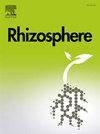Nitrogen management in rice under crop rotation and nitrogen level adjustment: Comprehensive responses of soil, roots, and plant growth
IF 3.4
3区 生物学
Q1 PLANT SCIENCES
引用次数: 0
Abstract
High-quality japonica rice is widely valued in Asia, particularly in China's Taihu Lake region, for its unique taste and nutritional qualities. However, the excessive application of nitrogen (N) fertilizers threatens both rice quality and environmental sustainability, demanding a reconsideration of traditional agricultural practices. This study investigates the combined effects of different crop rotation systems and N fertilizer rates on N management in rice cultivation. It focuses on soil N dynamics, as well as the structural and physiological responses of rice root systems and above-ground growth. A field experiment was conducted in the Taihu Lake region for two years, following a split-plot design that included two rotation patterns—rice-wheat and rice-morel—and two levels of N application: the conventional rate and a 10% reduction. The cultivar ‘Suxiangjing 100’ was used. Variables such as soil inorganic N content, root morphology, root H+ and NO₃– uptake, N-metabolizing enzyme activities, and plant biomass and N accumulation were systematically analyzed. The rice-morel rotation combined with a 10% reduction in N markedly increased both nitrate and ammonium N contents in the soil, particularly in the 0–20 cm and 20–40 cm layers. This treatment also significantly enhanced root length, surface area, and volume, especially in the topsoil layer. Root tips exhibited a greater capacity for H+ and NO₃– uptake, especially in shallow soil. Furthermore, this treatment substantially boosted nitrate reductase (NR) and glutamine synthetase (GS), especially during the heading and maturation stages, with enzyme activities significantly higher (p < 0.05). Both plant biomass and N accumulation were markedly higher, demonstrating improved growth and nitrogen use efficiency (NUE). Correlation analyses indicated a significant positive relationship between root morphology and N absorption capacity in the top 10 cm of soil (p < 0.01). Adjusting crop rotation patterns and N application rates can significantly enhance soil N status, optimize root system morphology, and improve plant growth and N accumulation, thereby enhancing N management in rice. Overall, the rice-morel rotation with a 10% N reduction demonstrated strong potential for optimizing rice's overall N utilization and growth performance.
求助全文
约1分钟内获得全文
求助全文
来源期刊

Rhizosphere
Agricultural and Biological Sciences-Agronomy and Crop Science
CiteScore
5.70
自引率
8.10%
发文量
155
审稿时长
29 days
期刊介绍:
Rhizosphere aims to advance the frontier of our understanding of plant-soil interactions. Rhizosphere is a multidisciplinary journal that publishes research on the interactions between plant roots, soil organisms, nutrients, and water. Except carbon fixation by photosynthesis, plants obtain all other elements primarily from soil through roots.
We are beginning to understand how communications at the rhizosphere, with soil organisms and other plant species, affect root exudates and nutrient uptake. This rapidly evolving subject utilizes molecular biology and genomic tools, food web or community structure manipulations, high performance liquid chromatography, isotopic analysis, diverse spectroscopic analytics, tomography and other microscopy, complex statistical and modeling tools.
 求助内容:
求助内容: 应助结果提醒方式:
应助结果提醒方式:


